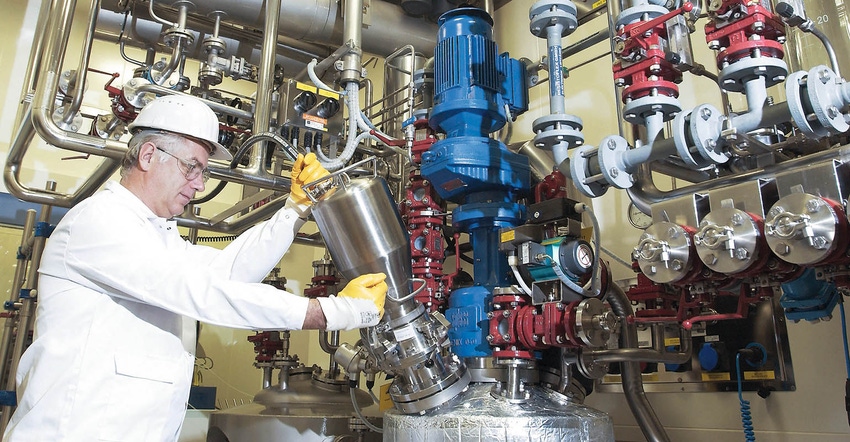Li-ion Battery Production Recipe Includes These Key Ingredients
LANXESS itemizes its comprehensive offering of materials for battery production at The Battery Show Europe
May 24, 2023

Specialty chemicals company LANXESS will be at the Battery Show Europe showcasing its portfolio for batteries for electric and hybrid vehicles. The event in Stuttgart is Europe’s largest trade fair for cutting-edge technologies and production processes in this fast-growing segment.
LANXESS offers numerous key raw materials along the entire value chain for the production of lithium-ion batteries. These include raw materials for cathode materials and electrolytes, ion exchange resins for extracting and recycling ultra-pure metal compounds for cathode materials, coolants, and colorants for high-voltage applications as well as polyurethane (PU) casting compounds for protecting electronic battery components. Another key product area features flame retardants for high-performance plastics and non-flammable electrolytes that help to improve safety inside and outside battery cells.
The company positions itself as a sustainable and reliable supplier of materials for European battery producers. “Our extensive product range allows us to provide support for setting up local value chains,” stated Dr. Martin Saewe, who is heading LANXESS’s initiative for electromobility and circular economy. “Among the areas that we are focusing upon are concepts for establishing circular material flows in the recycling of batteries, further improving the carbon footprints of electric vehicles.”
Flame retardants for plastic components: Flame-retardant high-performance plastics in particular are used in electric vehicles for components such as battery modules, battery housings, and high-voltage connectors, as well as for charging infrastructure. To ensure effective flame-retardant properties for plastic components of these types, LANXESS offers numerous phosphorus-based and bromine-based flame retardants for various polymers.
Orange plastics to indicate danger: The color orange is used for high-voltage components in electric cars as a safety feature to warn and thus protect mechanics during maintenance and assembly tasks or first responders in rescue operations. The plastics dyed with Macrolex Orange HT offer excellent stability in terms of color and temperature.
Enabling effective battery cooling: Fast-charging of electric vehicle batteries—which is the direction the market is going—results in the generation of considerable amounts of heat. To dissipate this heat effectively, battery cells are cooled directly by means of immersion cooling. LANXESS offers a range of synthetic fluids for this purpose, such as phosphoric esters. They are electrically non-conductive and highly flame-retardant. These are key properties to ensure safe fast charging under any conditions. LANXESS brings its expertise in flame-retardant thermal fluids to the task.
Electrolyte formulations and raw materials for conducting salts: Saltigo, a LANXESS subsidiary based in Leverkusen, has entered a cooperation with Guangzhou Tinci Materials Technology Co. to produce electrolyte formulations for lithium-ion batteries. The Chinese company is one of the world’s leading manufacturers of lithium-ion battery materials. Tinci supplies battery cell manufacturers across Europe with ultra-pure formulations from LANXESS.
LANXESS is also a leading producer of anhydrous hydrofluoric acids, phosphorus chemicals, thionyl chloride, and fluorosulfonic acid. These vital raw materials are the basis for electrolyte salts such as lithium hexafluorophosphate (LiPF6) and lithium bis(fluorosulfonyl)imide (LiFSI) – all key ingredients in electrolyte formulations. With its fully integrated asset park at its Leverkusen site, LANXESS can help local producers of electrolyte salt to set up local and sustainable battery component manufacturing in Europe.
Cathodes made from lithium iron phosphate (LFP): Lithium iron phosphate (LFP) is becoming more widely used as a cathode active material that offers a sustainable and cost-effective alternative to materials containing cobalt and nickel. Key precursors for LFP include not only lithium carbonate but also phosphorus chemicals and technical iron oxides. As Saewe explained, “Thanks to our world-class facility in Krefeld-Uerdingen, we are one of the world’s largest producers of iron oxides. LANXESS is also among the leading producers of phosphorus chemistry. So, as a supplier of these key ingredients, made in our world scale assets in the heart of Europe, we can reliably support the growing European demand for LFP.”
Project for lithium extraction: The specialty chemicals company’s project in El Dorado, Arkansas, USA, focusing on the commercial and sustainable extraction of battery-grade lithium from local brine, is proceeding according to plan. LANXESS has partnered with Standard Lithium Ltd. to generate ultra-pure lithium carbonate from the brine that historically had only been used for bromine extraction. A key next milestone in this project is the outcome of a “Front End Engineering Design Study,” which should deliver the framework parameters for the technical and commercial side of the process.
Battery recycling with Lewatit resins: Ion exchange resins under the LANXESS Lewatit brand have long been used in ore processing to extract and refine battery-grade nickel and cobalt, as well as purify lithium brine of all kinds. These resins may also be used in another application, the recycling of lithium-ion batteries. “We are working on Lewatit resins, which can be applied to recover lithium, nickel, cobalt, and manganese from the black mass that generates during battery recycling, so these metals can be recycled for new cathodes,” stated Saewe.
About the Author(s)
You May Also Like





